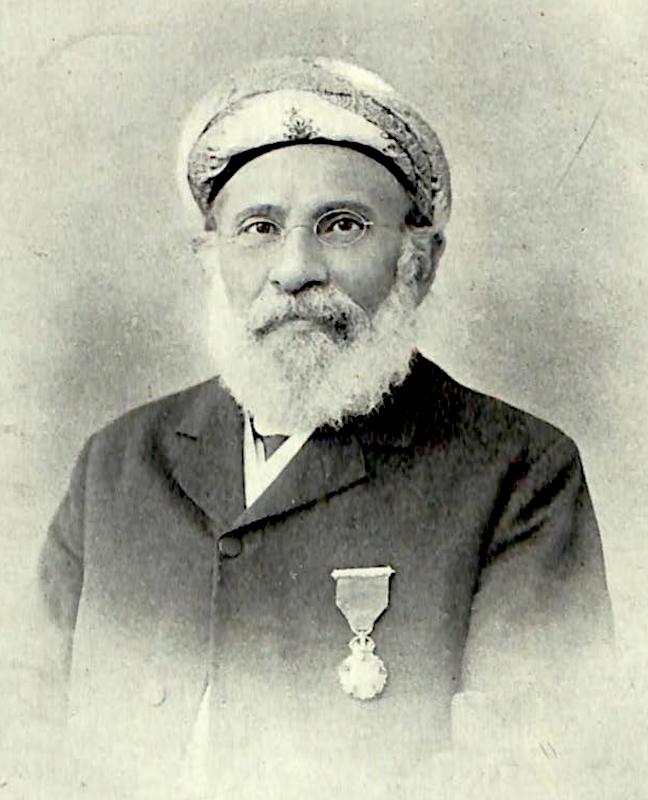Colour photographs by Ramachandran Venkatesh, scanned image and and text by Jacqueline Banerjee. Many thanks to Ash Nallawalla for pointing out earlier confusion here between this and the original college building. You may use the images below without prior permission for any scholarly or educational purpose as long as you (1) credit the photographer or source, and (2) link your document to this URL or cite the Victorian Web in a print document. Click on the images to enlarge them.

Elphinstone College (Sir Cowasji Jehangir Readymoney, K.T., Building, and State Record Office), involving two engineer-architects, both working for the Public Works Department, and both prominent contributors to Mumbai's building history: the Bombay-born Parsi, Khan Bahadur Muncherji Cowasji Murzban (1839-1917), and John Adams (1845-1920).
Adams had entered the department in 1869, and had completed the earlier building for the college, designed by James Trubshawe, in a similarly striking Venetian Gothic style, with fine decorative detailing. In the course of his career, Adams would be responsible for more than 25 buildings in the city.

Murzban in 1900. Source: Murzban, facing p. 28.
Murzban, however, was the first to be commissioned for work on this new building. Younger than Adams, he had travelled widely both in India and Europe, and trained at the Poona Engineering College, entering the Public Works Department in 1857. He worked on the building shown above "in both a supervisory and an architectural capacity" (London 141). It was opened on 2 February 1889, and is listed as no. 13 of Murzban's works (Murzban 83), having cost 7,41,497 rupees to construct.
The details of the its architectural history are a little complicated. It was originally designed by Murzban as a smaller building for the Central Press, then enlarged to hold the State Records. The government then decided that it should house the college as well. Sir Cowasji Jehangir Readymoney, the Parsi philanthropist who had funded that building, was not to be forgotten: the new building would be called after him. The same account continues by quoting a resolution of 20 May 1886, announcing (rather apologetically but still encouragingly) that from this point Murzban would be working with Adams' design rather than his own:

Closer view of the central part of the building. The bust of Parsi philanthropist Sir Cowasji Jehangir Readymoney can be seen over the main entrance.
The design prepared by Mr. Adams is approved, and Government are pleased, to record the following opinion with reference to the revised design submitted by Mr. Murzban, from whose drawings the lower portion of the [Central Press] building up to top of first floor has already been constructed. The Executive Engineer, Presidency, to be informed that Government fully appreciate the merits of his design, and that, it was only after mature deliberation that they came to the conclusion that the general effect of design No. 4 by Mr. Adams, would be more satisfactory. Government are fully alive to the zeal shown by Mr. Murzban in meeting, by amended designs, the objections which had been made, and Government are convinced that Mr. Murzban will continue to perform his important duties in connection with this and other great works as heretofore. [Murzban 65-66]
Murzban clearly did continue to work zealously, because Preeti Chopra says in her excellent chapter entitled "The Biography of an Unknown Native Engineer" that "no one worked on a larger number of public buildings [in Bombay] than did Murzban, who also designed many of them" (83). He and Adams rose to different positions: Adams became Architectural Executive Engineer and Surveyor to Government, and Murzban became Executive Engineer, Presidency. But they must often have interacted, as here. Indeed, during Adams's three-months' leave over the winter of 1891-92, for instance, Murzban was appointed to act in both capacities (Murzban 75).
Chopra tells us that Murzban became a fellow of RIBA in 1889, a few years before his retirement in 1893 after 36 years in public service. So he did achieve recognition at the time. But sadly, such figures, so important in making Mumbai a grand city worthy of its title, Urbs Prima in Indis, are still apt to be neglected in architectural histories of the Raj. As for the college itself, this was one of the first great institutions of the Victorian age in Mumbai. It still bears the time-honoured name of Lord Elphinstone (1779-1859), Governor of Bombay from 1819 to 1827, even though the building itself is called after the college's original Parsi benefactor.
Bibliography
Chopra, Preeti. A Joint Enterprise: Indian Elites and the Making of British Bombay. Minneapolis and London: University of Minnesota Press, 2011.
Murzban, Muncherji Cowasji. Leaves from the Life of Khan Bahadur Muncherji Cowasji Murzban. Bombay: Ferdoonji Byramji Marzban, 1915. Internet Archive. Contributed by the Digital Library of India. Web. 7 October 2020.
London, Christopher W. Bombay Gothic. Mumbai: India Book House, 2002.
Nurses' Quarters (Front View), St George's Hospital, [Bombay]. British Library Online Gallery (which gives some information about John Adams). Web. 7 October 2020.
Created 7 October 2020